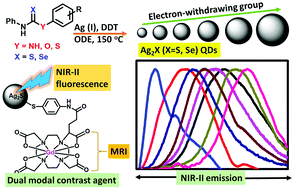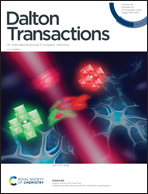Tunable NIR-II emitting silver chalcogenide quantum dots using thio/selenourea precursors: preparation of an MRI/NIR-II multimodal imaging agent†
Abstract
Aqueous-stable, Cd- and Pb-free colloidal quantum dots with fluorescence properties in the second near-infrared region (NIR-II, 1000–1400) are highly desirable for non-invasive deep-tissue optical imaging and biosensing. The low band-gap semiconductor, silver chalcogenide, offers a non-toxic and stable alternative to existing Pd, As, Hg and Cd-based NIR-II colloidal quantum dots (QDs). We report facile access to NIR-II emission windows with Ag2X (X = S, Se) QDs using easy-to-prepare thio/selenourea precursors and their analogues. The aqueous phase transfer of these QDs with a high conservation of fluorescence quantum yield (retention up to ∼90%) and colloidal stability is demonstrated. A bimodal NIR-II/MRI contrast agent with a tunable fluorescence and high T1 relaxivity of 408 mM−1 s−1 per QD (size ∼ 2.2 nm) and 990 mM−1 s−1 per QD (size ∼ 4.2 nm) has been prepared by grafting 50 and 120 monoaqua Gd(III) complexes respectively to two differently sized Ag2S QDs. The size of the nanocrystals is crucial for tuning the Gd payload and the relaxivity.



 Please wait while we load your content...
Please wait while we load your content...